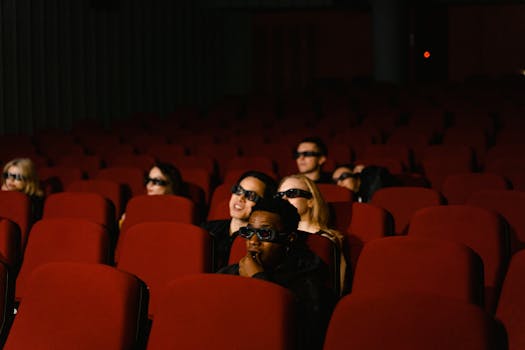TV Shows
TV Shows That Revolutionized Their Genres
Discover tv shows that revolutionized genres. See how groundbreaking stories, bold characters, and format innovations changed TV forever and continue to inspire new series and fans alike.
Advertisement
Some shows jump off the screen and stick with us. These special tv shows don’t just reflect trends—they redefine entire genres, making you see television in an entirely new way and raising the storytelling bar.
Whenever a truly groundbreaking tv show arrives, everything else has to catch up. Networks reimagine what’s possible, writers grow bolder, and audiences expect richer characters. These giant leaps forward change the TV landscape for everyone.
This article will show you why certain tv shows became the new standard-bearers for dramas, comedies, sci-fi, and more. If you’re curious how these game-changers worked their magic, read on for revealing examples and practical insights.
Breaking Genre Rules for Lasting Impact: Analyzing What Works in TV Shows
Recognizing the real-life methods behind iconic tv shows helps you spot storytelling trends that last. When you identify how these boundary-pushers changed the rules, you can appreciate fresh series on a different level and anticipate what’s coming next.
Instead of quietly following formulas, revolutionary tv shows break—or totally rewrite—the rules. Regardless of whether the genre is crime, comedy, or sci-fi, these bold moves inspire writers and attract lasting fan devotion.
Narrative Risks That Paid Off for Audiences
Channeling movie-like ambition, shows like The Sopranos let characters evolve unpredictably, causing viewers to question their assumptions. Audiences hung on confessions in dim kitchens and bad-news stares, just like real conversations.
On Lost, nonlinear timelines became normal. One character might say, “I can’t trust you,” and surprise flashbacks make viewers see why. This risk taught networks to support bolder plotting rather than safe repetition.
TV shows that use ambitious risks force audiences to become active participants. That’s why new series often blend timelines or genres—a legacy of these early innovators.
Distinct Visual Choices Redefining TV Aesthetics
TV used to rely on bright lighting and simple sets, but Breaking Bad introduced moody colors and stunning desert scenes, changing how creators think about TV cinematography. Visuals became as important as plot.
Audiences quickly started to notice on-screen style. For example, after Mad Men, shows began using fashion and set design as storytelling tools. Viewers pay attention to costumes, props, and even tiny background choices.
Now, tv shows rely on cinematographers and designers to craft unique visual signatures—just like movies. This elevates standards and helps new series stand out in a crowded market.
| TV Show | Genre Before | Revolutionary Element | Takeaway Action |
|---|---|---|---|
| The Sopranos | Mob drama | Character-driven ambiguity | Notice subtle shifts in motivation—from episode to episode |
| Lost | Adventure mystery | Nonlinear timeline | Track character flashes and emotional arcs for context |
| Breaking Bad | Crime drama | Cinematic color, moral complexity | Watch lighting and color changes to signal mood |
| Mad Men | Workplace drama | Design as character cue | Analyze how props push themes forward |
| Fargo | Anthology crime | Genre-blending, stylized visuals | Spot tone shifts after key plot reveals |
Redefining Characters: Habits That Make Unforgettable TV Shows
Great tv shows create characters that shape popular culture and dialogue. You’ll remember their catchphrases, unique gestures, and defining moments years later because they don’t play by old TV character molds.
Every genre benefits from memorable characters. For instance, the gritty realism and complex personalities in The Wire made audiences rethink heroes and villains, driving conversations about empathy in storytelling.
The Art of the Flawed Protagonist
Flawed leads—like Tony Soprano—connect with fans because their everyday struggles mirror our own. “I’m just trying to do my job,” Tony mutters, sweating and battered, after a personal loss. Everyone recognizes that feeling.
Writers boost drama by showing doubts and mistakes on screen. This breaks TV’s tradition of perfect heroes, offering a more honest reflection of human nature and making tv shows relatable to a wider audience.
- Write everyday dialogue—create authenticity by scripting lines people use, such as “That’s just the way it is,” which resonates in workplace dramas.
- Reveal insecurities—give characters anxious glances or fidgeting hands that cue viewers to inner conflict, deepening emotional impact in every episode.
- Add tiny rituals—show personal habits like breakfast routines or nervous shuffles to signal change or stress without heavy-handed exposition.
- Mix good and bad—merge acts of kindness and sparks of cruelty in the same scene, so no character feels one-dimensional.
- Expand supporting casts—integrate diverse perspectives for contrast, strengthening main characters and making every episode richer.
When audiences notice these tricks, they become hooked on the little details that make tv shows feel alive and unpredictable.
Subverting Clichés Through Dialogue
Revolutionary tv shows dismantle clichés with fresh language. Sharp writers avoid outdated tropes, letting characters use slang, stammer, or trail off mid-sentence for realism.
Dialogues in Fleabag break the fourth wall, addressing viewers directly—“You know what it’s like”—inviting empathy and engagement, a tactic that spread to other series quickly.
- Embrace silence—script pauses or awkward gaps, letting actors convey doubt or tension with glances or shifts in body language. This is especially effective during emotional plot turns.
- Drop formal phrases—substitute natural speech for wooden lines to help characters feel like real people having genuine conversations on screen.
- Use inside jokes—give recurring jokes or callbacks only regular viewers understand, rewarding loyal audiences and adding layers to the story.
- Highlight contradictions—let characters say one thing while their faces reveal confusion or regret, so viewers can spot hidden motives and vulnerabilities.
- Let characters admit failure—show confessions or apologies, especially after mistakes. These moments signal growth and keep tv shows feeling fresh and relatable.
Honest, messy speech delivers a new level of emotional truth and beckons fans to pay closer attention in every episode.
Sparking Genre Crossovers: TV Shows That Blend Comedy, Drama, and More
Watching tv shows that mix genres gives you variety without switching the channel. These series pull you between laughter, suspense, and heartbreak all in a single episode, keeping every moment unpredictable and engaging.
What you might say at home: “It’s funny—I can’t tell if I’m supposed to laugh or cry.” That’s the mark of a show redefining its genre boundaries and expanding what audiences expect.
Unexpected Shifts in Tone
In Orange Is the New Black, one minute you’re laughing at a hallway prank, the next, those jokes transition into commentary on justice or heartache. Shifts like this maintain surprise and keep engagement high.
Showrunners embrace the messiness of real life, choosing contrasting music or smash cuts to jolt viewers between moods. Every episode feels more layered, reflecting the complicated feelings that come with being human.
This hybrid approach means fans rarely get bored—each episode of these tv shows challenges viewers to stay alert, picking up on emotional cues and moments of irony.
Genre Fusion in Science Fiction TV Shows
Stranger Things popularized a blend of horror, mystery, and family dramedy. You might see kids screaming about monsters, cut with parents bickering about curfew. That blend makes the fictional world feel unusually believable.
This technique encourages new tv shows to abandon old genre silos. Instead, writers deploy a mix that feels true to modern life—a jumble of mystery, drama, and humor packed together.
By following scenes where genres blend unexpectedly, you train yourself to spot storytelling trends and appreciate why hybrid tv shows keep building new audiences.
Transforming Structure: The Mini-Series and Anthology Boom
Mini-series and anthology tv shows provide a complete, satisfying story in a short span—no more waiting years for a resolution. That means more viewers can commit, knowing each season offers closure and variety.
Studios are now greenlighting flexible formats that let writers reset the cast or plot each season. Viewers benefit from tighter storytelling, fewer filler episodes, and bolder plot swings.
Building Self-Contained Stories With High Payoff
Anthologies like Black Mirror or Fargo deliver distinct worlds each season or even episode. Audiences experience the pleasure of a tight arc—setup, tension, and payoff—without losing momentum or patience.
This approach trains fans to watch carefully, picking up on thematic links rather than expecting a conventional arc. It becomes a game: “what connects these stories this time?”
The shorter structure teaches networks that audiences value quality over sheer episode count. Now, tv shows often compete to make their season finales especially rewarding, giving more attention to plotting and closure.
Tight Casts, Sharper Dialogue, and Creative Freedom
With fewer recurring characters, scripts get more focused. “We don’t have time for lazy jokes,” one showrunner might say. Tighter casts mean sharper lines, with every word pushing the plot forward.
Anthology writers take bigger creative swings. Freed from long-term continuity, they can chase novel ideas and surprise audiences with each new season or episode twist, often shifting tones or genres completely.
This lets fans enjoy each installment as its own experience, while still recognizing the style and voice of outstanding anthology tv shows across genres.
Rewriting Television History: Why These TV Shows Still Matter
Throughout television history, certain tv shows have set new standards for storytelling, visuals, and character. These innovators forced viewers and creators alike to reexamine what makes for truly great television, and continue influencing series emerging today.
Watching groundbreaking tv shows helps you develop a critical eye and deeper enjoyment of both new releases and classics. Each influential series highlighted here demonstrates how fresh ideas can set off a ripple effect across every genre.
The next time you find yourself absorbed in a daring drama or sharp comedy, remember these revolutionary tv shows. Pay attention to their risks, innovations, and character quirks to appreciate just how much they’ve changed the medium for good.
Trending Topics

How International Films Are Shaping Global Audiences
Learn how international films influence cultures, expand audiences, and redefine global cinematic storytelling today.
Keep Reading


